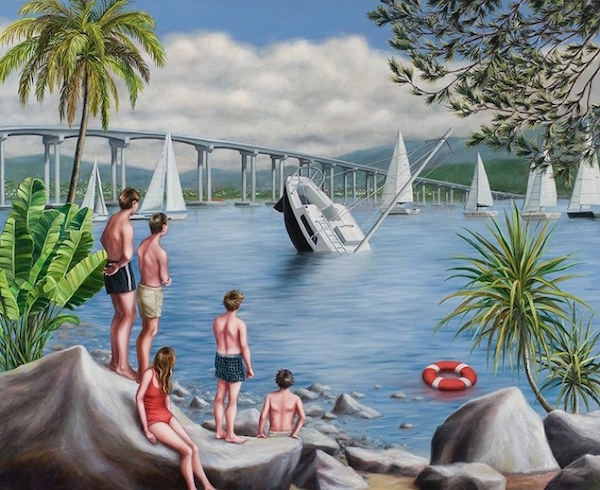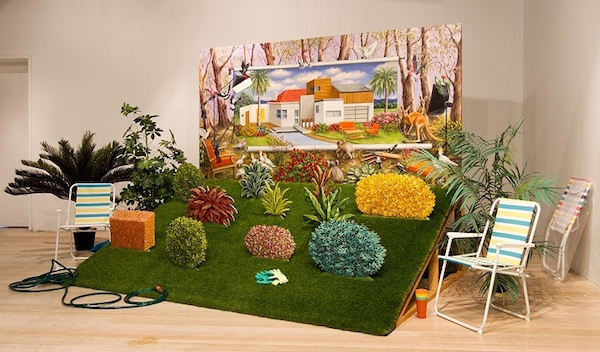Hobart painter Amber Koroluk-Stephenson is a graduate of the Tasmanian School of Art and has a long list of exhibitions, grants, residencies and awards on her CV. Most recently, in 2017, after a residency at Cite Internationale des Arts in Paris, Amber staged an exhibition at the Anna Pappas Gallery in Prahran. It was titled Shadows on the Wall. (Image above is “Lonely Idol”, 2017.)
From her Hobart studio, Amber produces some extraordinary images. The words they bring to mind are emotional ones: startling, challenging, hilarious, disturbing.

And yet, when it comes to describing her art in words, Amber herself is controlled and understated.
“My work and practice are connected in an ongoing process of evolving and expanding … I’m always interested in refining both my skills and knowledge, and finding new ways to express my ideas.” (Private communication, 2017)
Unsettling
This restraint is not so evident in her paintings.

Here is Andrew Harper in The Mercury:
“Koroluk-Stephenson’s art is unsettling. It has a dreamlike quality, not soft-focussed and comforting, but the fragmented feel of actual dreams, flashes of partly recalled, barely understood imagery whose meaning is just out of reach.” (Harper, 2016)
The Pappas Gallery website describes:
“an alternate world in which geographical distinctions of place are troubled, confounded, remade and rearticulated.”

In contrast, Amber writes to me of routine. She treats her practice as a job, “one that I am usually always happy to come to.”
I begin to suspect I am in the presence of a true visual artist. Maybe everything Amber wishes to express is contained in the paintings.
Complex, Contradictory, Challenging
The work is certainly rich with ideas.
There is often humour. Even Amber’s most unsettling paintings can be punctuated with a small mad detail: a limp glove or a clownish hand.

At the same time, there is an almost “overwhelming number of themes, from the destruction of the natural environment to the absurdity of suburbia and notions of greed and desire” (Hawthorne, 2013).
On her own website Amber says she explores “perceptions of paradise, structures of theatre and facade, and paradoxes of taming or staging the landscape” (Koroluk-Stephenson, 2017).
Theatre
Amber’s works are deeply engaged with the idea of performance and representation, often with a flatness and artificiality that suggest a theatre set.

Stairs go nowhere. The perspective is slightly off. The lighting is flat and unnatural.
In the collection Outside the Garden Wall, exhibited in 2016 at the Bett Gallery, Hobart, Amber’s works depict people as audience, standing with their backs to the viewer, watching something or studying a scene.

Andrew Harper writes,
“these faceless people are staring at an image, just as we are. If someone stood behind me as I look at these works, that person would see my back, staring at the backs of the people in the painting, staring at the artwork that is being stared at in the artwork.” (Harper, 2015)
In the installation Paradise Dreaming, a painting sits above a tilted plastic lawn.

“It looks like a terrible theatre set from some frightening amateur play, rendered expertly in paint while confusing some innocent native animals and birds as it blocks the view of the actual Australian bush these creatures inhabit.” (Harper, 2015)
This is playful.
It is also deadly serious.
At Home and Not-at-Home
Beyond the Gate, Koroluk-Stephenson’s solo exhibition of 2014, featured paintings of sunny suburban scenes, which appear at first glance to be banal in their cheery familiarity. People are at leisure or working on their pretty gardens.

But slowly we are drawn in. We see the awkward angles, the impossible detail, and we realise things are not quite right. The perspective is slightly off. The light is hard and too bright. The paintings have a strange “meaty texture” (Hawthorne 2014). The plants are weirdly heavy. And yet the whole thing appears strangely unstable.
“The picture planes shift … The apple tree is laden with far too much fruit, and it’s all falling neatly onto the blanket below.” (Bradford 2014)
Uncanny
Koroluk-Stephenson’s work is a confrontation between the realistic and the artificial. Her landscapes are familiar, but fragmented and destabilised. There is a sense of displacement and absence.
They make us uneasy. These works are infused with the uncanny: that sense of disturbance that arises when the familiar becomes unfamiliar, when we should feel at home, but we feel not-at-home. (Royle, 2003, Freud, 1919)

This is no suburban paradise. In these bright full gardens, there is a sense of emptiness. There are flat planes and empty spaces. The people, even the moving ones, seem strangely static. Faces are turned away.
Absence
Much of Koroluk-Stephenson’s work is has a pervading melancholy. Even in the busy suburban scenes, there is a strange sense of absence. In later works the people have almost disappeared.
In a 2014 exhibition Half full/ Half Empty, Koroluk-Stephenson presented a suite of suburban images in which the central house has been physically cut out. The viewer is invited, or required, to fill in the void with images from his or her own memory or imagination.
Dreams
The objects and landscapes in Koroluk-Stephenson’s work are both real and not real. Scenes have a heightened naturalism, but they are tipped and fragmented. They appear intimately familiar, and yet there is a sense of a deeper meaning that vanishes as we try to grasp it.

This is the experience of dreams.
There is an immediately apparent inheritance from de Chirico and Dali. But Amber’s work with its “cascade of imagery”(Harper 2017), its awareness of history and the natural environment, and its deep understanding of symbolsim, is also strikingly contemporary.
Amber Koroluk-Stephenson is represented by the Anna Pappas Gallery, Melbourne and the Bett Gallery, Hobart.
References and Further Reading
http://www.koroluk-stephenson.com.au/about
http://www.bettgallery.com.au/artists.html
Bradford, Jess (2014), “Text for solo exhibition Half Full / Half Empty” at Archive Space ARI, Sydney. http://www.archivespace.net/2108725-025-half-full-half-empty
Freud, Sigmund (1919), “The Uncanny”. In The Complete Psychological Works of Sigmund Freud, Vol XVII. Strachey, J (trans). London: Hogarth Press and the Institute of Psychoanalysis. http://web.mit.edu/allanmc/www/freud1.pdf
Greenhalgh, David (2016), “A conversation with the Past & a Vocabulary for the Future”. Text for solo exhibition Outside the Garden Wall at Bett Gallery, 2016. http://www.koroluk-stephenson.com.au/texts
Harper, Andrew (2015), “Public Hangings, Ken Urban”, Tas Weekend, The Mercury, August 15-16, 2015, p.20. Exhibition review of Ken Urban, at Contemporary Art Tasmania, 2015
Harper, Andrew (2016) “It’s hard to look away”, TasWeekend, The Mercury, April 2-3, 2016 p.21 Exhibition review for Outside the Garden Wall, Bett Gallery, Hobart
Harper, Andrew (2017) “Lost in No Space”. http://www.koroluk-stephenson.com.au/texts
Hawthorne, Lucy (2013), “All that Glisters is Not Gold”. Text for solo exhibition Quixotic Habitation at Mop Projects, Sydney 2013 http://www.mop.org.au/pdf/131024_2.pdf
Hawthorne, Lucy (2014), “Beyond the Gate”. Text for solo exhibition Beyond the Gate at Bett Gallery, 2014. http://www.koroluk-stephenson.com.au/texts
McGarry, Miriam (2017), “There’s No Place Like Homeland”. http://www.koroluk-stephenson.com.au/texts
Royle, Nicholas (2003), The Uncanny. New York: Routledge.
Speer, Rebecca (2013), “Amber Koroluk-Stephenson: Urban utopias with an edge”. Concrete Playground Published October 29 , 2013. http://concreteplayground.com/sydney/event/amber-koroluk-stephenson-quixotic-habitation

Leave a comment